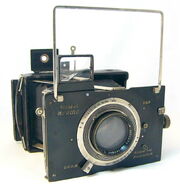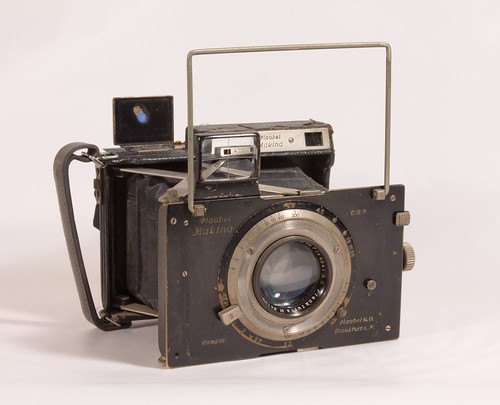The Makina was a long-lived strut folding camera made by the German company Plaubel from around 1911 to around 1960. (For the model made in the 1970s and 1980s by the same company after it became Japanese, see Makina 67.)
The 4.5×6 viewfinder model[]
The original Makina (sometimes called Baby Makina by today's collectors) was launched in 1911 or 1912, and was a strut folding camera taking 4.5×6cm film plates. It had a central Compur dial-set shutter. The lens was a Plaubel Anticomar 7.5cm f/4.2, f/3 or f/2.8. The diaphragm selector was on the side of the front plate. The focusing was made by a small wheel on the other side of the front plate, as for all later Makinas.
Small variations are reported to exist in the viewfinder type:
- folding, simple one-lens, on the back
- folding, special two-lens, on the back
- folding, off-centre, one lens on the front plate and the eyepiece on the rear; and also folding frame finder (like later Makinas)
The camera was quite similar to other strut folding baby cameras of the time, like the Goerz Tenax or the Gaumont Block-Notes, but it would have more descendants.
The 6.5×9 viewfinder models[]
Dial set[]
The Makina I was launched in 1920, and was a strut folding film plate camera with a Compur dial-set leaf shutter to 1/200, very similar to the Baby Makina except for its size.
The very first model had a simple folding finder on the rear, and a fixed Plaubel Anticomar 10cm f/4.2 or f/3.2 lens.
Then it gained an off-center folding finder, with one lens on the front plate and the eyepiece on the rear, with the addition of a folding frame finder. Later the eyepiece became larger, with a blue-toned glass.
The lens was an interchangeable Plaubel Anticomar 10cm f/3.2 or f/2.9 (see "Makina lenses" below).

Dial set Plaubel Makina I, early model, with Rollex Patent back (right) and mounted rare Goerz-Dagor Zeiss 6cm f/9 lens.
Rim set[]
The next step was the introduction of the Compur rim-set shutter to 1/200 on the Makina I. At about this time, the Anticomar lens switched from 3 to 4 elements.
The viewfinder Makina I was stopped around 1935. All the viewfinder Makinas were in black finish.

Sync added Brian Wolfe - ClassicCameras.us

With original film pack back Brian Wolfe - ClassicCameras.us
Plaubel Makina 1 with 10cm 2.9 Anticomar
The 6.5×9 rangefinder models[]
Between-the-lens shutter[]

|
| Makina II, black. Picture by Willboy2010. (Image rights) |
The Makina II, launched in 1933, was like the rim-set Makina I with the addition of a coupled rangefinder, separate from the viewfinder. Plaubel would mount the same rangefinder unit on its folding Roll-Op II camera. A manual parallax corrector for the eyepiece was available as an option. This camera could take all the lenses available for the Makina I.
At some point, the diaphragm selector was moved from the side of the front plate to a more usual location around the lens.
Later the finish of the Makina II switched from black to chrome.
Behind-the-lens shutter[]
In 1936, the Makina IIS replaced the Makina II, with a behind-the-lens Compur shutter to 1/200. With it came a new range of lenses. The previous lenses had to be interchanged in two parts, one in front of the shutter and the other at the rear. This was quite inconvenient, and the new model had lenses interchangeable as single units. One can tell a Makina IIS from a Makina II by the bulkier lens, and the two square rangefinder windows (the II had one square and one round window). After World War II, production of the Makina IIS was resumed, with flash synchro for a Plaubel magnesium flash unit, and coated lenses.
In 1949, the Makina III replaced the Makina IIS, with the full flash synchro (electronic and magnesic), a shutter locking button, no self-timer and two holding plates attached to the front plate.
In 1953 was launched the last version Makina IIIR, with a synchro contact on the bottom right corner of the front plate, and a Compur-Rapid shutter to 1/400.
Fixed lens[]
There were two uncommon variants with a rangefinder and a fixed lens, both made just after the war.
The Makina IIa (or Makina 2a as written on the facade) had a between-the-lens Compur-Rapid shutter to 1/400 and a fixed Plaubel Anticomar 10cm f/4.2 or Schneider Xenar 10cm f/4.5, and a black finish.
The Makina IIb (or Makina 2b) is apparently a simpler version. Its front plate was black with an octagonal chrome motif around the Plaubel Anticomar 10cm f/4.2 lens, a shutter to 1/200 or maybe 1/400 and no self-timer.
The stereo models[]
Two stereo models of the Makina existed. Both are very rare.
The Stereo Makina 45×107 was launched in 1911 or 1912, at the same time as the original Baby Makina. It took exposures on 45×107mm plates. It had a shutter to 1/150, and two Plaubel Orthar 6cm f/6 or Anticomar 7.5cm f/4.2 or f/3.9. The finder was first on the rear part, then the front lens was moved to the front plate while the eyepiece was on the rear.
The Stereo Makina 6×13 was launched in 1926. It took exposures on 6×13cm plates. From the outset it had the more modern type of viewfinder, with a variation in the eyepiece, first simple, then enclosed in a square plate. The shutter was a Compur stereo dial-set to 1/100. The lenses were Plaubel Orthar 9cm f/6 or Anticomar 9cm f/2.9.
Makina lenses[]
Most of the Makina interchangeable lenses were made by Plaubel. Only the standard lenses (10cm focal length) were fully coupled to the rangefinder. With the tele lenses, you could focus with the rangefinder and then set the given distance on the lens helical. With the wide angle lens, you could focus with the rangefinder with the bellows fully extended, then set the bellows to the wide-angle position and set the distance on the helical, a slow procedure to say the least.
Between-the-lens shutter[]
These lenses could be mounted on the Makina I designed for interchangeable lenses, and on the Makina II. Only the standard lenses (10cm focal length) were coupled to the rangefinder. Here is a list:
- 6cm f/9 Goerz-Dagor C. Zeiss Jena (rare, only 25 made)
- 7.3cm f/6.8 Rapid Weitwinkel Orthar (marked Rap. Weitw. Orthar)
- 10cm f/4.2 Anticomar (from about 1936)
- 10cm f/3.9 Supracomar
- 10cm f/3.2 Anticomar (rare, with the first Makina I)
- 10cm f/2.9 Anticomar three element (until about 1932)
- 10cm f/2.9 Anticomar four element (from about 1932)
- 21cm f/6.3 Tele Makinar
- 21cm f/5.4 Tele Makinar
- Tele Peconar 3 (variable focal length)
Behind-the-lens shutter[]
These lenses could be mounted on the Makina IIS, III and IIIR. Here is a list:
- 7.3cm f/6.8 Rapid Weitwinkel Orthar (marked Rap. Weitw. Orthar)
- 10cm f/4.2 Anticomar (said to be better than the f/2.9 lens)
- 10cm f/2.9 Anticomar
- 19cm f/6.3 Tele Makinar
- 19cm f/4.8 Tele Makinar
- Tele Peconar 3S (variable focal length)
Before the war, these lenses were marked "S" to distinguish them from the older Makina lenses. They were sold in a coated version after the war. There was some sort of mark indicating it, maybe a colored circle.
A Carl Zeiss Jena Tessar 10.5cm/4.5 has been sold with Makina mount at a Christies auction (23/4/2004). It is unknown if it was original or adapted.
Makina accessories[]
Original Plaubel accessories:
- ground glass focusing back
- blank back (when nothing else is mounted)
- depth of field scale plate
- plate film holder for 6.5×9cm, #113
- pack film holder for 6.5×9cm, #112
- 6×9cm rollfilm back for 120 film, #111/1
- 6×6cm rollfilm back for 120 film, #111/3
- viewfinder mask for 6×6cm, #158/3
- film reducing mask for 4.5×6cm
- 24×36mm film back for 35mm film, #111/7
- viewfinder mask for 24×36mm
- tripod plate
- focal plane shutter unit
- flashgun, with battery/capacitor inset
- metal front caps
- lens hood with filter insert
- filter and close-up lenses (first # for Makina I and II, second # for Makina IIS, III, IIIR)
- close-up lens T 1,5, fits all lenses, distance of 65cm with standard lens, #125/1, #483
- close-up lens DIN, fits all lenses, distance of 45cm with standard lens, #485
- close-up lens R 0,1, fits only wide angle and standard lenses, for lifesize reproduction, #125, #484
- yellow, light, #118, #505
- yellow, medium, #118/1, #505/1
- yellow, strong, #118/2, #505/2
- orange, #118/3, #505/3
- green, #120, #506
- red, #120/1, #506/1
- blue, #120/2, #506/2
- ultra-violet, #120/3, #506/3
filter thread size (behind the shutter) :41,5mm
Links[]
In English:
- Makina at the Cosmonet Classic Camera site
- Makina II and Roll Film Back at Jo Lommen's website
- Plaubel Makina page at Retrography.com by Simon Simonsen
In Spanish:
- Plaubel Makina at Historia de Bolsillo by J. Noir
In French:
- At www.collection-appareils.fr